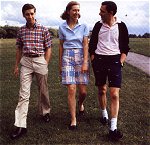En Vacances part one:reading |  |
Do you ever wonder sometimes how many treasures pass you by, simply because life sometimes gets so full that you just don't have the time to really look or listen? I've been thinking about this a lot recently, mainly because I've just had a week away from a computer, away from TV, just sat in a cottage in the heart of France with a pile of books, tapes and my mountain bike for regular forays into the countryside: a time in fact during which I was able to catch up with some of those treasures which had been passing me by. I used to read a great deal you know, in the days before a 'proper' full time job and the advent of computers (or at least the advent of the computer into my life). In recent years, however, I'm somewhat ashamed to admit that I have been more than slack with my reading, and you could sometimes count the number of books read in a year on the fingers of your hands, which I think is a dreadful admission to have to make. This year, however, has been better, and I managed a full fist during my week in France. I've already hinted at the greatness of Walter Mosley in my review of the George P Pelecanos Nick Stefanos trilogy (more on the second of my holiday books, his King Suckerman in the interview article coming soon), and it was 'The White Butterfly' that was my first read last week. The last of the three novels that make up the Picador anthology, The White Butterfly is one of Mosley's series that pits Easy Rawlins against the world of post-war LA, with it's race and class divisions in harsh and spiteful evidence. As a result, these are stories of pride and strength, stories of love, loss and struggle and as such should be read by everyone whose heart still beats. Quite simply, essential. | |
 | I had to read Alain Fournier's classic Le Grand Meaulnes if only for the reason that the author was born a stones throw from the village I was staying in, and that the Lost Domain that gives the English translation its other common title was supposedly the chateau in Nancay, just a few kilometres up the road. The book had sat unread on my shelves for seven years since it had been purchased as part of a post-graduate reading list, and had thus been abandoned after a few pages when it became clear that this book was going to be of no use in telling me how to work in a school classroom. In a way I am glad it left that impression at the time, because it made it all the more of a delight to discover the magic of the book now. It's a recognised classic (Penguin reckon so anyway, and it's in their Modern Classics collection) so I will say no more to embarrass myself other than to say it is a beautiful romantic tragedy that you can read in a day. Preferably whilst sitting in a garden in the Val de Loire… |
My Brothers Gun had some fine recommendations on the cover, including one from Sonic Youth's Lee Ranaldo and the assurance from the friend who loaned it to me that it could be read in half an hour. An exaggeration perhaps, but readable in a morning certainly, due more than anything to the fact that it is great taught flowing prose with a raw insistence, as if Salinger had written a screenplay merging Badlands with Thelma and Louise. This is one terrific book and I insist you read it as soon as possible. | |
 | Last of the fist was the extraordinary Life of the Automobile. First published in 1929 by Russian Ilya Ehrenburg, this version, superbly translated by Joachim Neugroschel, is a marvellous text of Futurist-Expressionist Surrealism, and as Ehrenburg himself insists at the book's outset, it 'is not a novel; it is a chronicle of our time'. The analysis of the growth of the automotive industry within the book's pseudo-fictional structure is dynamic, immensely readable and unsettling, perhaps the more so for the passing of time, and the realisation of the razor sharpness of the author's insight and makes this essential reading for anyone even remotely interested in either automotive, political or artistic history. ©Alistair Fitchett 1999 |